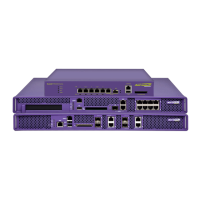Summit WM3000 Series Controller System Reference Guide 21
● Short slot protection – The slot time is 20 µs, except an optional 9 µs slot time may be used when the
basic service set (BSS) consists of only ERP stations (STAs) capable of supporting this option. The
optional 9 µs slot time should not be used if the network has one or more non-ERP STAs associated.
For independent basic service sets (IBSS), the Short Slot Time field is set to 0, corresponding to a 20
µs slot time.
Proxy-ARP
Proxy address resolution protocol (ARP) is provided for MU's whose IP address is known. The WLAN
generates an ARP reply on behalf of a MU (if the MU's IP address is known). The ARP reply contains
the MAC address of the MU (not the MAC address of controller). Thus, the MU does not awaken to
send ARP replies (increasing MU battery life and conserving wireless bandwidth).
If an MU goes into power save mode without transmitting at least one packet, its Proxy ARP will not
work.
HotSpot / IP Redirect
A hotspot is a Web page users are forced to visit before they are granted access to the Internet. With the
advent of Wi-Fi enabled client devices (such as laptops and PDAs) commercial hotspots are common
and can be found at many airports, hotels and coffee shops. The hotspot redirects the user’s traffic on
hotspot enabled WLANs to a web page that requires them to authenticate before granting access to the
WLAN. The following is a typical sequence for hotspot access:
1 A visitor with a laptop requires hotspot access at a site.
2 A user ID/ Password and hotspot extended service set ID (ESSID) is issued by the site receptionist
or IT staff.
3 The user connects their laptop to this ESSID.
4 The laptop receives its IP configuration via DHCP.
5 The user opens a Web browser and connects to their home page.
6 The controller re-directs them to the hotspot Web page for authentication.
7 The user enters their User ID/ Password.
8 A Radius server authenticates the user.
9 Upon successful authentication, the user is directed to a Welcome Page that lists (among other
things) an Acceptable Use Policy.
10 The user agrees to the usage terms and is granted access to the Internet. (or other network services).
To setup a hotspot, create a WLAN ESSID and select Hotspot authentication from the Authentication
menu. This is simply another way to authenticate a WLAN user, as it would be impractical to
authenticate visitors using 802.1x. For information on configuring a hotspot, see “Configuring Hotspots”
on page 120.
IDM (Identity Driven Management)
Radius authentication is performed for all protocols using a Radius-based authentication scheme (such
as EAP). Identity driven management is provided using a Radius client. The following IDMs are
supported:
● User based SSID authentication — Denies authentication to MUs if associated to a ESSID configured
differently by their Radius server.

